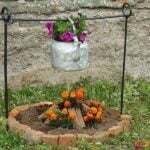Retaining wall landscaping ideas are essential for creating a visually appealing and functional outdoor space. Whether you’re dealing with sloping terrain or simply looking to add dimension to your garden, retaining walls play a crucial role in maintaining the structural integrity of your landscape. In this article, we will explore various creative and practical ways to enhance your outdoor space using retaining walls.
When it comes to landscaping, retaining walls serve as a crucial element in preventing soil erosion and managing water runoff. They can also be utilized to create distinct levels and terraces, allowing for more diverse planting options and defining functional spaces within your yard. Understanding the purpose of retaining walls in landscaping is key to making informed decisions about their design, materials, and maintenance.
In the following sections, we will delve into different aspects of retaining wall landscaping ideas, from selecting the right materials for construction to incorporating vertical gardens and water features into your design. Additionally, we will discuss how lighting and proper drainage can be utilized to enhance the aesthetics and longevity of your retaining wall.
Whether you’re looking to revamp an existing landscape or embark on a new project, this comprehensive guide will provide you with inspiration and practical tips for achieving an attractive and resilient outdoor environment.
Choosing the Right Materials for Your Retaining Wall
When it comes to choosing the right materials for your retaining wall, there are several factors to consider in order to achieve both aesthetic appeal and structural integrity. The materials you choose will ultimately determine the overall look and feel of your retaining wall landscaping, so it’s important to make an informed decision.
Stone
Stone is a popular choice for retaining walls due to its durability and natural aesthetic. Whether you opt for natural stone or concrete blocks that resemble stone, this material can add a timeless and rustic charm to your landscape design. Stone also offers versatility in terms of shape and size, allowing for creativity in the design process.
Timber
For a more rustic or traditional look, timber is another material option for retaining walls. Treated hardwood or railway sleepers can create a warm, organic feel in your outdoor space. Keep in mind that timber may require more maintenance than other materials, as it is susceptible to decay over time.
Brick
Brick offers a classic and refined look for retaining walls. With various colors, textures, and patterns available, brick can complement a wide range of architectural styles and landscaping designs. This versatile material is not only durable but also provides a clean and structured appearance.
When considering the right materials for your retaining wall landscaping ideas, it’s essential to factor in the style of your home or outdoor space, as well as your personal preferences and maintenance capabilities. By carefully selecting the materials used for your retaining wall, you can ensure that it not only serves its purpose but also adds beauty and value to your landscape for years to come.
Incorporating Vertical Gardens Into Your Retaining Wall Design
When it comes to retaining wall landscaping ideas, incorporating vertical gardens can add a unique and visually appealing element to your outdoor space. Vertical gardens, also known as living walls, are a great way to maximize limited space and add greenery to your landscape. By integrating plants into your retaining wall design, you can create a lush and vibrant backdrop for your outdoor area.
To incorporate vertical gardens into your retaining wall design, it’s important to choose the right plants that will thrive in a vertical environment. Consider using low-maintenance plants such as succulents, ferns, and trailing vines that are suitable for vertical growth. Additionally, installing a drip irrigation system can ensure that your vertical garden receives the proper amount of water without causing damage to the retaining wall structure.
In addition to adding aesthetic appeal, vertical gardens can also provide environmental benefits such as improved air quality and insulation for your outdoor space. The combination of greenery and natural elements in your retaining wall design can create a peaceful and relaxing atmosphere for you and your guests to enjoy. Whether you have a small or large retaining wall, incorporating a vertical garden is a creative way to transform it into a beautiful and functional feature in your landscape.
Utilizing Lighting to Enhance the Aesthetics of Your Retaining Wall
When it comes to retaining wall landscaping ideas, one often overlooked aspect is the use of lighting to enhance the aesthetics of your retaining wall. Proper lighting can not only make your wall a focal point in your landscape but also provide safety and security at night. There are several ways to utilize lighting to bring out the beauty of your retaining wall.
One popular option is to install LED strip lights along the top of the wall, which can provide gentle, ambient lighting that highlights the texture and color of the materials used. Another option is to incorporate low-voltage spotlights into the design, which can be placed strategically to illuminate specific features or plants in the garden bed behind the wall. Additionally, solar-powered lights can be an environmentally-friendly choice, offering soft illumination without adding to your energy bill.
Incorporating lighting into your retaining wall design allows you to enjoy your outdoor space well into the evening hours while creating a warm and inviting atmosphere. It’s essential to carefully plan and install your lighting to ensure that it complements your overall landscape design and doesn’t create glare or harsh shadows. With the right lighting, your retaining wall can become a breathtaking focal point in your outdoor space both day and night.
| Retaining Wall Lighting Options | Benefits |
|---|---|
| LED Strip Lights | Highlights texture and color of materials; provides ambient lighting |
| Low-Voltage Spotlights | Illuminates specific features or plants; adds visual interest |
| Solar-Powered Lights | Environmentally-friendly; creates soft illumination without adding to energy bill |
Creating Functional Spaces With Tiered Retaining Walls
Tiered retaining walls are a great way to create functional spaces in your landscaping design. Not only do they help with erosion control and managing slopes, but they also add visual interest and depth to your outdoor space. Here are some ideas for utilizing tiered retaining walls to create different functional areas in your yard:
- Tiered Garden Beds: Use the different levels of your retaining wall to create tiered garden beds for planting flowers, herbs, or vegetables. This not only adds beauty to your landscape but also makes it easier to access and maintain your plants.
- Seating Areas: Incorporate built-in seating into the tiers of your retaining wall to create cozy nooks for relaxing or entertaining. Add some outdoor cushions, pillows, and even a small table for a comfortable and inviting space.
- Outdoor Kitchen or Bar: If you have a steep slope in your yard, consider using tiered retaining walls to create levels for an outdoor kitchen or bar area. You can have different tiers for the cooking area, dining space, and even a bar counter for serving drinks.
Overall, tiered retaining walls offer endless possibilities for creating practical and attractive spaces in your backyard. By utilizing the different levels of the walls, you can maximize the use of your outdoor area while adding aesthetic appeal.
When considering incorporating tiered retaining walls into your landscaping design, it’s essential to work with a professional who can ensure proper construction and drainage. Proper installation is crucial for the longevity and effectiveness of tiered retaining walls in managing slopes and creating functional spaces in your yard.
Incorporating Water Features Into Your Retaining Wall Design
When designing your retaining wall landscaping, consider incorporating water features to add an element of tranquility and relaxation to your outdoor space. Water features can range from a simple fountain or pond to a more elaborate waterfall design. Here are some ideas for incorporating water features into your retaining wall design:
- Create a cascading waterfall: If you have the space and budget, consider adding a cascading waterfall to your retaining wall. This feature can create a soothing sound of flowing water and add visual interest to your landscape design.
- Install a bubbling fountain: A bubbling fountain is a great option for smaller spaces or where there is limited access to electricity. These fountains are easy to install and maintain, and they can add a touch of elegance to your retaining wall.
- Build a pond at the base of the retaining wall: If you have enough space, consider creating a small pond at the base of your retaining wall. This can be home to water plants, fish, or other aquatic life, adding another layer of biodiversity to your landscape.
Water features not only enhance the aesthetic appeal of your retaining wall but also contribute to creating a peaceful and serene atmosphere in your outdoor living space. With proper planning and installation, these elements can provide years of enjoyment for you and your family as well as create an oasis-like environment for entertaining guests.
The Importance of Proper Drainage in Retaining Wall Landscaping
Proper drainage is a crucial factor to consider when it comes to retaining wall landscaping. Without adequate drainage, water can build up behind the wall, causing hydrostatic pressure that can lead to structural damage and eventual failure of the retaining wall. Here are some important considerations for ensuring proper drainage in your retaining wall landscaping design.
Perforated Pipe Systems
One effective way to manage drainage behind a retaining wall is by installing a perforated pipe system. This involves placing a perforated pipe at the base of the wall, which helps to collect and redirect water away from the structure. Additionally, using geotextile fabric around the pipe can help prevent soil particles from clogging the pipe over time.
Weep Holes
Weep holes are small openings that are strategically placed in the retaining wall to allow for proper drainage. These openings help to relieve water pressure and prevent buildup behind the wall. Weep holes should be located at regular intervals along the base of the wall and can also be incorporated near any areas where water may collect.
French Drains
In some cases, particularly in areas with heavy rainfall or poor soil drainage, incorporating a French drain into your retaining wall design may be necessary. A French drain consists of a trench filled with gravel or rock and a perforated pipe that redirects water away from the retaining wall and surrounding landscape.
By incorporating these drainage solutions into your retaining wall landscaping design, you can ensure the longevity and structural integrity of your walls while preventing potential issues such as erosion, soil saturation, or damage caused by hydrostatic pressure. Proper drainage not only protects your investment but also contributes to a visually appealing and functional landscape.
Maintaining and Caring for Your Retaining Wall
In conclusion, implementing retaining wall landscaping ideas can significantly enhance the aesthetics and functionality of your outdoor space. From choosing the right materials to incorporating vertical gardens, lighting, tiered walls, and water features, there are endless possibilities for creating a stunning and practical retaining wall design. However, it is crucial to remember that proper maintenance and care are essential for the longevity of your retaining wall.
Regular inspection and maintenance can help identify any issues or damage early on, preventing costly repairs in the future. It is important to keep an eye out for signs of erosion, cracking, bulging, or leaning. Additionally, keeping the area around the retaining wall free from excessive moisture buildup and ensuring proper drainage are also crucial aspects of maintaining the structural integrity of the wall.
Furthermore, following manufacturer’s guidelines for cleaning and sealing materials such as concrete or stone can help prolong the life of your retaining wall. By staying proactive with maintenance and addressing any issues promptly, you can enjoy your beautifully landscaped retaining wall for years to come. Remember that a well-maintained retaining wall not only adds visual appeal to your outdoor space but also provides critical support for sloped landscapes.
Frequently Asked Questions
How Do You Landscape Around a Retaining Wall?
Landscaping around a retaining wall can enhance its appearance and blend it into the surrounding environment. It’s important to consider the design of the wall and choose plants, shrubs, or flowers that complement its style. Creating flower beds or planting ground cover on the sloped areas can soften the look of the retaining wall while adding visual interest.
What Is the Cheapest Option for a Retaining Wall?
The cheapest option for a retaining wall is typically using timber or pressure-treated wood. These materials are affordable and readily available, making them a popular choice for budget-friendly projects. While timber retaining walls may not offer as much durability as other options, they can still be effective for managing soil erosion and creating terraced landscapes.
How Do You Dress Up a Retaining Wall?
Dressing up a retaining wall can involve various strategies to improve its aesthetic appeal. One approach is to use decorative stone veneer, stucco, or brick facing to give the wall a more polished and refined appearance.
Additionally, incorporating built-in lighting fixtures, ornamental planters, or artistic murals can further enhance the visual appeal of a retaining wall and make it an attractive focal point in outdoor spaces.

Welcome to my gardening blog! I am passionate about plants and enjoy sharing my knowledge and experiences with others. In this blog, I will write about everything related to gardening, from tips on how to get started to updates on my own garden projects.





